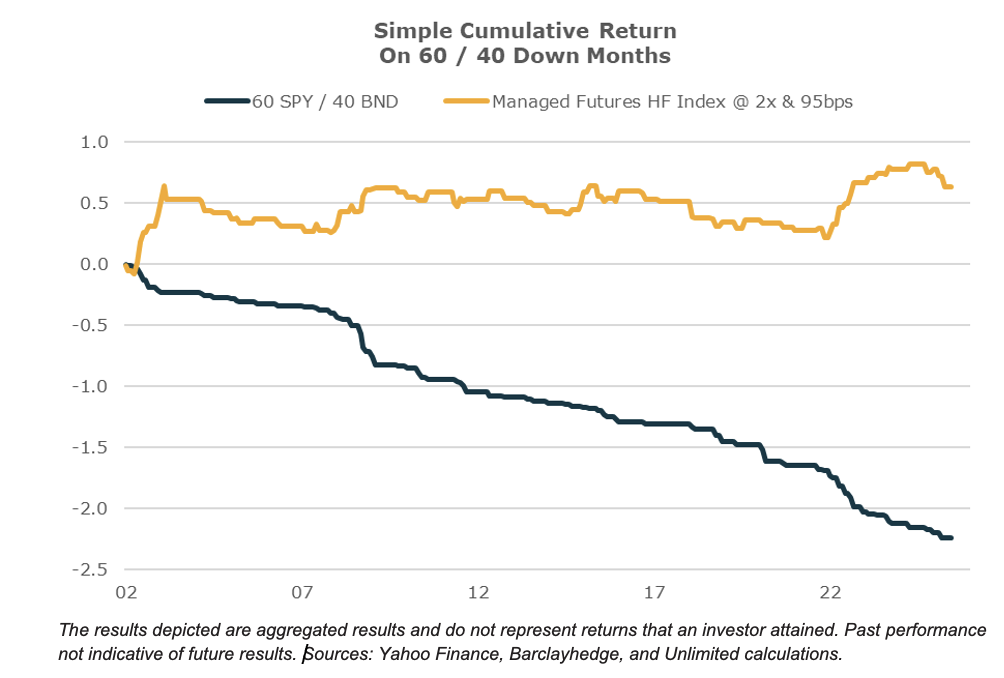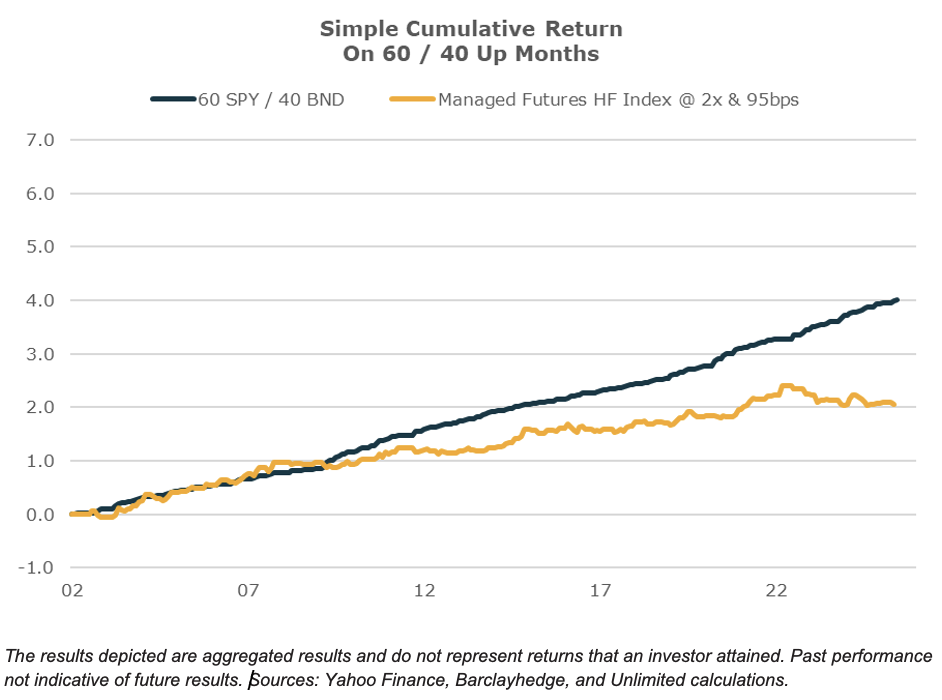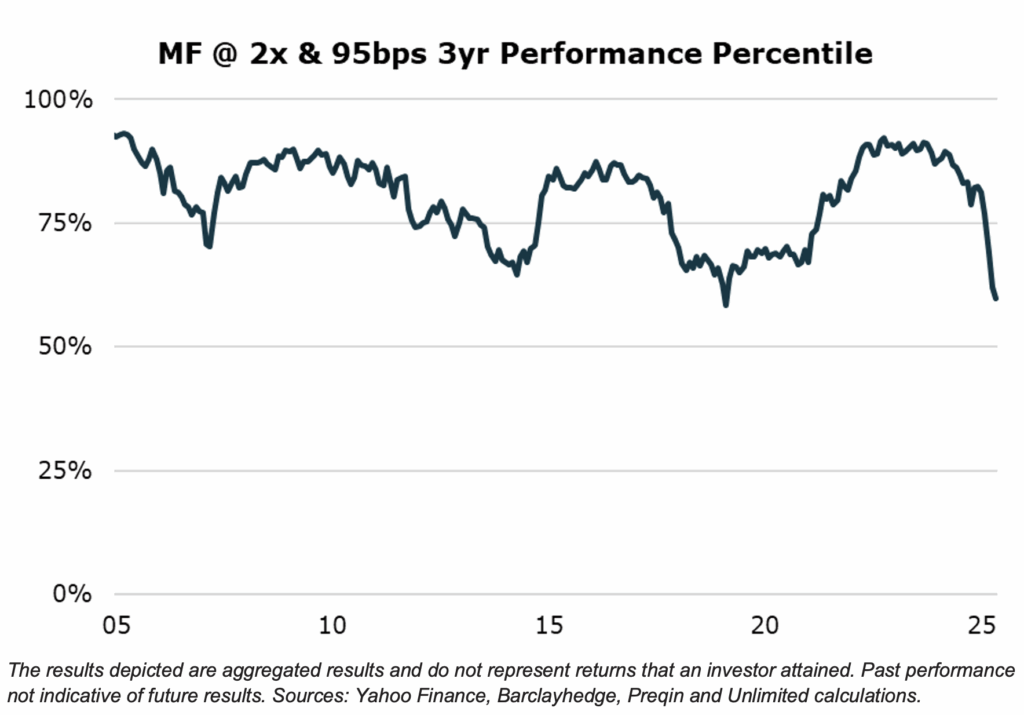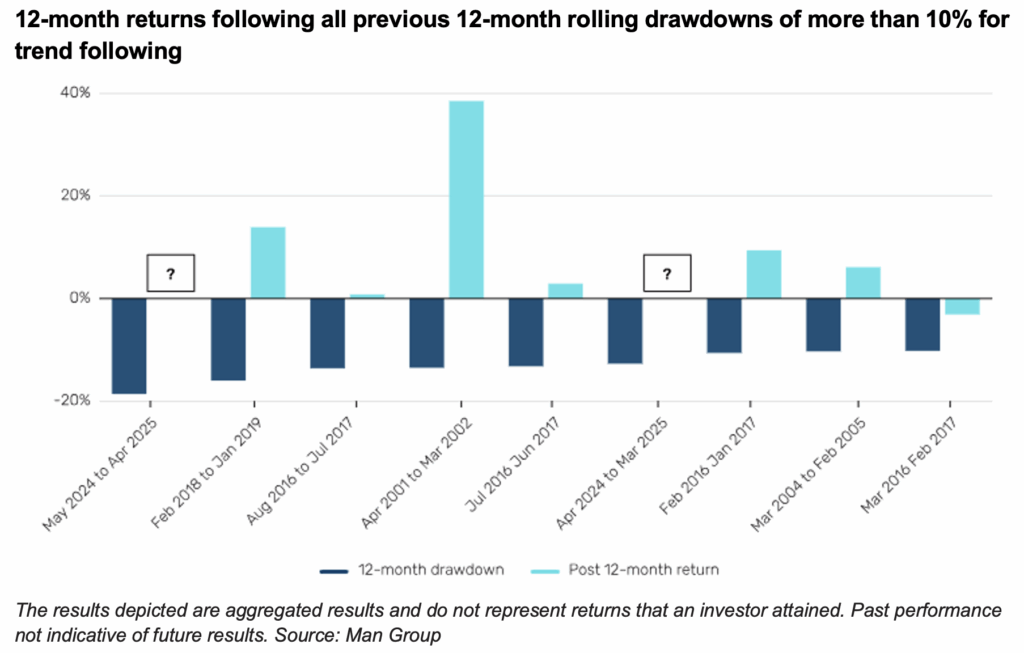Published by Bob Elliott July 10, 2025
Allocators often face challenges designing portfolios that can help limit losses in down market environments. Despite the need, there are few investment offerings that perform well when other assets underperform but don’t also suffer from burdensome drag on the portfolio over time. Some folks use buffer products, but those are often structured in a way that can limit upside. Others add out of the money puts, but that often results in meaningful negative return drag over time as premiums go unused. Managed Futures strategies are one of the few approaches that may balance the loss limiting attributes while maintaining the ability to generate positive returns over time.
Managed Futures managers typically hold long and short positions across liquid global futures contracts – covering fixed income, currencies, commodities, and equity indexes. The approach typically draws on price momentum as a key determinant of positioning, with the view that often recent price action can provide insightful signals into the pressures ahead. And because these managers can go both long and short assets at any point in time, they can be well positioned to generate positive returns during environments which prove to be challenging for long-only strategies.
The chart below highlights the benefit of Managed Futures strategies in the context of a range of other complements to a traditional 60/40 portfolio. Over the last couple decades, an incremental allocation to Managed Futures alpha offered an attractive improvement in the risk/return of a traditional 60/40 portfolio, particularly if that return can be accessed with a less burdensome fee drag than typical 2&20 fees.

The results depicted are aggregated results and do not represent returns that an investor attained. Past performance not indicative of future results. Sources: Yahoo Finance, Barclayhedge, HFR, Bloomberg, Eurekahedge, UBS (Credit Suisse), FRED, Pitchbook, Cambridge Associates, and Unlimited calculations.
One challenge everyday investors face is many Managed Futures managers offer their strategy as a bond alternative which can lead to low target returns relative to other portfolio assets like stocks. These lower target volatility returns also tend to require a much larger capital investment to achieve significant protection at the portfolio level which leads to line-item risks for allocators.
But investors don’t have to settle for these low target returns as given. Structural options exist to create products that can relatively easily target twice the notional positions of the manager’s capital leading to higher target returns and greater cash efficiency while preserving a similar return profile.
The chart below compares the higher target return version (in this case 2x) for Managed Futures alpha relative to the standard 60/40 portfolio. As depicted below, the resulting cumulative returns outpace 60/40 over time and show strong returns particularly in periods where traditional 60/40 returns are weak.

The defensive attributes of Managed Futures alpha become clearer when examining performance during periods of negative 60/40 returns. As the chart below highlights, Managed Futures alpha has the ability to generate positive returns during prolonged periods of negative returns, helping to offset weaker broader portfolio performance.

Unfortunately, many defensive strategies suffer from negative returns during positive asset market environments. Meanwhile Managed Futures strategies have historically been able to generate moderate positive returns and generally the drawdown profile has been relatively limited.

Over the last couple of decades, Managed Futures managers have shown their value as a complement to 60/40 portfolios. Recently hedge fund strategies have become more accessible via the ETF wrapper, offering investors access to that alpha at 95bps of fees, rather than the typical 2 & 20, paired with improved liquidity and transparency.
Had an investor allocated 20% to the above-modeled Managed Futures strategy from the period of 2002 to present their experience would include: improved performance, lower volatility, and less meaningful drawdowns in depth and duration. Arguably a pretty attractive combination of diversification benefits.

With increasing apprehension around the durability of the US equity rally, it seems to be an opportune time for allocators to broaden their exposure though the addition of a Managed Futures strategy with the flexibility to go short and provide defensive benefits if markets turn. However, navigating the manager selection process and attempting to evaluate hundreds of offerings is a daunting task.
That’s where alpha indexing can help alleviate the lift for allocators and reduce the time to market. The inherent diversification benefits of an index approach could improve return consistency while the lower fee structure allows the investor to harvest more of the alpha generated. Alpha indexing products that target higher returns present the opportunity to achieve consistent above median return outcomes without the burden of individual manager selection.
As depicted in the chart below over the past two decades, a Managed Futures strategy run at a higher target return using a lower cost approach would have generated consistent above median returns relative to individual manager selection.

The recent drawdown may offer an opportune time to integrate Managed Futures into your portfolio. As Man Group recently highlighted, over the past 20 years the returns of Managed Futures strategies have typically been positive following meaningful drawdowns, suggesting a possible tailwind for these strategies ahead.

For decades Managed Futures strategies have shown to offer diversification opportunities for many traditional long-only portfolios. The thoughtful integration of leverage paired with fee reduction through indexation, can enhance the ever so elusive downside protection complement. With signs of increased volatility becoming seemingly pervasive of late the set it and forget it long-only approach of the recent years may no longer present an attractive return profile, whereas adding a lower-cost Managed Futures strategy at a higher target return as a complement may benefit many investors going forward.
For informational and educational purposes only and should not be construed as investment advice. The historical analysis discussed herein has been selected solely to provide information on the development of the research and investment process and style of Unlimited. It does not constitute an offer to sell or a solicitation of an offer to buy any security. Opinions expressed are our present opinions only. No Representation is being made that any investment will or is likely to achieve profits or losses similar to those shown herein. No investment strategy or risk management technique can guarantee return or eliminate risk in any market environment. The material is based upon information which we consider reliable, but we do not represent that such information is accurate or complete, and it should not be relied upon as such. The historical analysis should not be construed as an indicator of the future performance of any investment vehicle that Unlimited manages.
